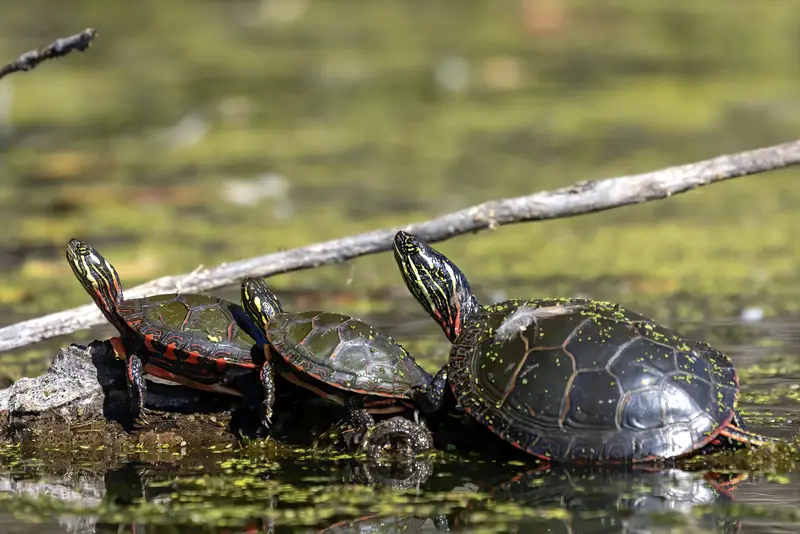Do Turtles Eat Other Turtles? [Full Guide]

If you’ve ever seen a turtle in the wild, you’ll know that they eat just about anything. This may lead you to wonder, do turtles eat other turtles? In short — yes, turtles can and will eat each other, although it’s not particularly common.

Turtles may fight or eat each other for a number of reasons. Their spaces are overcrowded, they don’t have enough food, or they’re kept with turtles of different sizes. Whatever the reason, you should know what to expect if you’re planning to house two turtles together.
Contents
Table of Contents
Do Turtles Eat Other Turtles?
Will turtles eat other turtles? Turtles will eat just about anything that is put in front of them, but they usually won’t go after each other unless they’re put in extreme circumstances. In the wild, it’s usually only the young turtles that are at risk of being eaten by other turtles. Adult turtles won’t usually go after one another. When cannabalism happens within an aquarium setting, it’s usually because their enclosure is too small and they become aggressive with each other.
Do Snapping Turtles Eat Other Turtles?
Snapping turtles are predators and will regularly go after a host of animals. Other turtles are no exception. If a smaller turtle is around and the snapping turtle is hungry, it will make a meal of that smaller turtle.
Other snapping turtles aren’t even exempt. Adult snapping turtles frequently eat young hatchlings as they try to adapt to their new watery homes.

Do Turtles Eat Their Babies?
It’s not common for turtles to eat their own babies, but it can happen. Even snapping turtles don’t usually eat their own babies. Instead, the hatchlings are at risk of predation from other adult snappers.
Still, turtles may eat their eggs if they don’t have a suitable nest for them. They may also consume the eggs if they’re lacking in calcium and need the extra nutrition.
Can Pet Turtles Fight Each Other?
Pet turtles will absolutely fight with each other. They are solitary animals and don’t like sharing spaces.
Wild Turtles
In the wild, turtles are solitary and don’t live with each other. They may sometimes be found in groups. This is because the environmental conditions are favorable, so turtles will tolerate each other.
But, they have plenty of open space to stay away from one another when they want solitude. In captivity, enclosures aren’t large enough for each turtle to have their own space.
Turtles As Pets
It’s not recommended to keep two pet turtles in the same tank, especially two turtles of the same gender.
The smaller the enclosure is, the more likely the turtles are to become aggressive and pick fights with each other.
Signs Of Aggression
Usually, fighting will begin subtly. Aggression usually begins with one turtle fluttering their feet in front of the other. If this doesn’t work, aggression will progress to biting and chasing.
When you first notice these signs of aggression, you should separate the turtles immediately. If you allow these behaviors to continue, the aggression will only increase.
There have been reports of pet turtles biting off limbs and eating parts of other turtles when they have been housed in small enclosures together.
One turtle owner reported that they came home to one of their turtles missing all four legs — a fate that came at the “hands” of its tankmate.
Here are some other reasons why turtles may fight each other:
Stress From Inhospitable Environment
Sometimes, even the best-meaning turtle owners don’t provide their turtles with the right environment. When turtles are living in an enclosure that isn’t right for them, it stresses them out. Add an extra turtle on top of that and you have a recipe for disaster.
Hunger
Extreme hunger can cause turtles to go after each other and eat each other. Usually this scenario happens in the wild. Hopefully, this is never the case in home aquariums because people should be feeding their pets.
They Become Territorial
Aquariums usually aren’t large enough to house two turtles safely under the best conditions.
If you keep two turtles of the same sex together, they may become angry with each other and fight. It is always best to give each turtle its own enclosure so they can have plenty of space to be happy and healthy.
Mating
Males will frequently bite during the mating process, both in the wild and in captivity. This kind of biting is not usually aggressive in nature and doesn’t usually cause harm.
As long as you are okay with your turtles mating, this type of biting isn’t much cause for concern.
Size Difference
Turtles that are different sizes should never be kept together. The smaller turtle is likely to be bullied and receive injuries. Some species, like snapping turtles, will even eat their own young. All in all, it’s just not a good idea.
Different Species
Just as it’s not a good idea to keep two turtles of the same gender together, it’s not a good idea to keep two turtles of different species together.
As a rule, different species of turtles don’t usually get along. Trying to house them together is easily asking for a fight.
Watch this live eating:
How To Stop Your Turtles Fighting And Eating Each Other
There are plenty of ways to prevent your turtles from fighting and eating each other. The easiest way to prevent it is to not keep two turtles together.
Keeping Them Seperate
But, if you’ve already housed two turtles together and they’re now fighting, don’t worry. The issue can be solved.
If your turtles are fighting, we recommend purchasing each of them a separate tank. If this isn’t possible, you can get dividers instead. These are usually clear, plastic squares that slide into place between the walls of your aquarium.
Dividers allow you to keep your turtles in the same aquarium, but separate.
Providing Them With The Right Habitat
Making sure your turtles have an enclosure suited to their needs cuts down on stress. When your turtles aren’t stressed, they’re less likely to fight.
The first step in making sure your turtles are happy is to make sure the temperature of your water is right. The right water temperature will vary depending on what species you have, so you’ll want to do research.
Keep your turtle’s tank clean. You wouldn’t want to live in a filthy home with lots of dirt, and neither do your turtles. Make sure to keep up a regular cleaning routine to rid the aquarium of dirt and algae.
Keep Them Fed
A turtle with a full belly is a happy turtle. If your turtles are receiving plenty of nutritious food, they will be less likely to fight with tankmates.
Diet is the most important thing in maintaining the health and happiness of your turtle. Each species has their own diet requirements, but they all need varied and nutritious diets.
If you don’t already know what kinds of food your turtles need, make sure to do your research and find out.
Conclusion
So, do turtles eat each other? Although turtles can eat each other, it’s not really common. As long as you keep them well fed, they shouldn’t be enticed to make a meal of one another.
That said, turtles don’t like to live together and might fight for many reasons. They might not have enough space, they might be stressed from a dirty tank, or they might not like the species they’re housed with.
Whatever the reason, it’s best to keep turtles housed separately so the answer in your house to do turtles eat turtles is no.
Want to know more? Find our what eats painted turtles here or whether turtles eat frogs here. You can also find all our turtle-related guides here.




![What Do Painted Turtles Need To Survive? [Full Care Guide]](https://allourcreatures.com/wp-content/uploads/2021/11/painted-turtle-2-768x513.jpg)
![Can Box Turtles Eat Grapes? [Full Guide]](https://allourcreatures.com/wp-content/uploads/2021/11/eastern-box-turtle-768x513.jpg)
